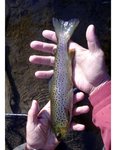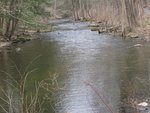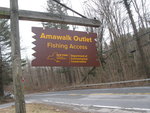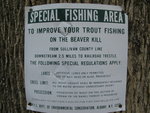Special trout fishing regulations have been used as a fisheries management tool in New York State and around the U.S. for many years. In many instances, but not always, these regulations are based on …
Stay informed about your community and support local independent journalism.
Subscribe to The River Reporter today. click here
This item is available in full to subscribers.
Please log in to continue |




Special trout fishing regulations have been used as a fisheries management tool in New York State and around the U.S. for many years. In many instances, but not always, these regulations are based on self-sustaining trout populations, type of habitat and angling pressure. Fisheries managers have implemented a variety of special regulations to protect and promote those fisheries. Depending on the resource, regulations may specify no-kill, size limits and/or reduced bag limits. Most special regulations mandate the use of single-hook-point artificial lures and flies in order to minimize hooking mortality. In some cases, they require barbless hooks. The philosophy here is to promote and protect trout while providing a quality fishing experience.
I became involved with special trout regulations back in the late 1960s as a fisheries biologist for the New York State Conservation Department, now known as the NYS Department of Environmental Conservation (DEC). At that time, the fisheries manager in Region 3 assigned me to survey and manage Amawalk Outlet, a small stream that runs between Amawalk Reservoir and Muscoot Reservoir. The stream is 2.5 miles long and is part of the vast NYC Department of Environmental Protection’s Croton Watershed complex. Special regulations were first implemented on Amawalk in 1963 after an electro-fishing survey conducted in 1961 found wild brown trout fingerlings. As a result, the fisheries manager decided to protect the fishery with the hope that spawning by brown trout adults would develop a substantial wild fishery, if managed accordingly. A no-kill regulation was implemented at that time. Two years later, the regulations changed after biologists found a fair number of large brown trout had populated the stream. So, in 1965, a one-fish, 14-inch size and bag limit was imposed, with only single-hook pointed artificial lures and flies permitted.
The brown trout population responded dramatically, as documented by electrofishing surveys. In other words, the void created by years of overfishing rapidly filled with wild trout because of the protection afforded by the regulations. So, for the first time in many years, some fairly large browns were taken by anglers. However, as the years passed, biologists found the trout were not growing as rapidly as before and that fingerlings were not as abundant. It didn’t take too long to realize that the population had exceeded the stream’s ability to support a large population of big fish. As a result, and after considerable discussion with the local chapter of Trout Unlimited, it was agreed that the size limit be changed from 14 inches to 10 inches, and anglers were also permitted to keep two trout a day. Those regulations were put in place for the 1969 season. As it turned out, changing the regulations on paper was a lot easier than getting local anglers to take a few trout home. Philosophically, most members of Trout Unlimited and other trout preservation organizations are very reluctant to kill fish, even when some harvest would help balance a slow-growing, overpopulated fishery. According to a biologist I spoke with recently, the DEC changed the regulations again, this time to three trout, 12 inches or larger per day, in order to simplify and standardize fishing laws. Frankly, based on my knowledge of Amawalk Outlet, I’m not convinced that many trout will attain that size.
Like the Amawalk, New York’s famous Beaverkill River was also subjected to overfishing. So, in 1964, the conservation department conducted a creel census on selected portions of the Beaverkill in order to determine angler success, evaluate fishing pressure and help develop future fisheries management plans for the river. At the end of the 1964 season, electrofishing surveys found that a very small portion of the trout collected was of wild origin; most trout came from seasonal stocking. Upon review of the data collected during the census, along with the results of electrofishing studies, biologists determined that the existing size and bag limits were too generous to support quality trout fishing on a season-long basis. As a result, biologists took the bold steps necessary to implement a no-kill regulation on a two-mile stretch of the river. Although the new regulations were not a big hit with locals, the conservation department learned that trout fishing improved dramatically.
Soon after, similar studies conducted on the Willowemoc Creek found that certain sections of that river also benefitted from no-kill regulations, which were put in place in 1969. Large trout that measured well over 12 inches soon became a normal catch for anglers. It was also not uncommon for fishermen to release several fish in that size range during the peak fishing season. By 1970, and because of the initial success with the catch-and-release regulations on both the Beaverkill and Willowemoc, the conservation department increased the total miles of catch and release to eight. It is important to note that the fisheries in both the Beaverkill and the Willowemoc are dependent on stocking, not natural reproduction by wild brown trout like the Amawalk. However, I have been told that wild rainbow trout from the Delaware River have made their way well into the Beaverkill system.
Now that I’ve described the wild fishery established for the Amawalk, along with the fisheries established in the Beaverkill/Willowemoc system, it is essential to note that not all rivers are created when it comes to managing their trout populations. The Amawalk is a small cold-water stream with a flow of around 25 cubic feet per second (CFS). It is affected by the discharge from a sewage treatment facility on the main tributary. Overtime, that discharge has negatively impacted the river’s trout population. In addition, the Amawalk is considered an unproductive stream in regard to food supply. As a result, its ability to produce a large population of large trout is severely limited. Consequently, the fishery cannot be managed as a no-kill because harvest is necessary in order to prevent a slow-growing, overpopulated fishery.
On the other hand, the Beaverkill and Willowemoc, at least in their lower reaches, are dependent on annual stocking to maintain fishing. Because of that, and because both rivers have a significant food base with a much greater flow, they can be managed for larger trout by controlling the number of fish stocked annually. Over time, we’ll see if the burgeoning wild rainbow trout population will affect the growth rate and size of the Beaverkill’s brown trout.
While special regulations have dramatically improved the quality of trout fishing throughout the U.S., there are some negative aspects associated with this type of management. Over time, catch-and-release fishing has risen to cult status to the degree that anglers who wish to keep a few trout are ostracized by fellow fishermen. I had that happen to me after I reeled in two rainbows from the Delaware Rive several years ago. That being said, it is important to keep in mind that trout must be harvested from some rivers like the Amawalk to ensure adequate growth and to maintain population balance. Biologically, not all rivers can support unlimited, healthy trout populations.
Since most special regulations are implemented on large, productive rivers like the Willowemoc and Beaverkill, they attract a great deal of fishing pressure. Consequently, those rivers are frequently overcrowded, particularly during peak times of insect activity. That can compromise the quality of the fishing experience. Nevertheless, special regulations on selected rivers across the nation have dramatically improved trout fishing.
Comments
No comments on this item Please log in to comment by clicking here